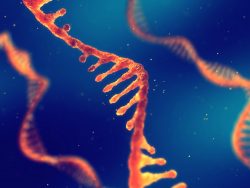 New findings from the University of Colorado Boulder may lead to new therapies for a variety of diseases including heart abnormalities and cancer. The study led researchers to becoming one step closer to answering the fundamental question as to how a stem cell, which is the raw material with which our tissue cells and organs are made of, knows what to become?
New findings from the University of Colorado Boulder may lead to new therapies for a variety of diseases including heart abnormalities and cancer. The study led researchers to becoming one step closer to answering the fundamental question as to how a stem cell, which is the raw material with which our tissue cells and organs are made of, knows what to become?
Deep inside our cells each one has the exact genome, a whole set of genes which provides the instructions for our cells’ function and form. If every blueprint is the same, then why does an eye cell act and look differently than a brain cell or skin cell?
The research team concluded that the molecular messenger RNA plays an indispensable role in differentiation of cells creating a bridge between our genes and our “epigenetic” machinery that regulates their turning on and off. When this bridge is flawed or missing, a stem cell on the way to becoming a heart cell will not learn to beat.
The research comes at a time when pharmaceutical companies are taking a huge interest in RNA. Although the new research is young, it is thought it could in the future inform development of new RNA targeted therapies ranging from therapies for cardiac abnormalities and cancer treatments.
All genes are not expressed in all cells all the time. Instead, each type of tissue has its own epigenetic program that will determine which genes get turned on or turned off at any time. The team determined that RNA is a master regulator of this epigenetic silencing. In the absence of RNA, this system does not work and it is critical for life.
Scientists have known for a long time that while each cell has the same genes, cells that reside in different tissues and organs express them differently. Epigenetics, the machines that switches them on or off, makes this possible. But just how this machinery works has not been clear.
In 2006 John Rinn who is now a professor of biochemistry at CU Boulder and Thomas Cech, the co-senior-author of the new paper, proposed for the first time that RNA might be the key. In a landmark paper published in Cell, Rinn showed that in the interior of the nucleus, RNA adheres itself to a cluster that is folds of proteins known as polycomb repressive complex (PRC2) which is thought to regulate gene expression. A variety of other studies have since found the same and have added that different RNAs also attach to other protein complexes.
The hot debate question became, does this actually matter in determining a cell’s fate? No less than 502 papers have been published since. Some indicated that RNA is key in epigenetics. Others dismissed its role as tangential at best.
In 2015 a biochemist and postdoctoral researcher named Yicheng Long in Thomas Cech’s lab set out to ask this same debate question again using the latest available tools. After a meeting at the BioFrontiers Institute where both labs are housed, Long ran into a computational biologist in Rinn’s lab. They formed a unique partnership.
They were able to use data science access and high powered computing to understand molecular patterns and evaluate RNA’s role in a new, quantitative approach. In the lab they used a simple enzyme to take out all the RNA in cells in an effort to understand whether the epigenetic machinery was still able to find it way to DNA to silence genes. Their answer was “no”.
It appeared RNA was playing the role of an air traffic controller, that is guiding the plane or protein complex to the correct spot on the DNA to land and then silence genes. For a third step, the team used the gene editing technology CRISPR to develop a line of stem cells that were destined to become human heart muscle cells but in which the PRC2 was incapable of binding to RNA. In other words, the plane could not connect with air traffic control and therefore lost its way and the process fell apart.
At day 7, the normal stem cells had started to look and act like heart cells. However the mutant cells did not beat. However, when normal PRC2 was restored, they began to act more normally. The team says they can now say without a doubt that RNA is critical in the process of cell differentiation.
Earlier research has shown that genetic mutations in humans which disrupt RNA’s ability to bind to these proteins, heightens the risk of fetal heart abnormalities and certain cancers. Ultimately the researchers see a day when RNA targeted therapies can be used to address such problems.
The new findings set a new scientific stage which shows an inextricable link between RNA biology and epigenetics. They could have significant implications for understanding and then addressing human disease in the future.
To view the original scientific study click below
RNA is essential for PRC2 chromatin occupancy and function in human pluripotent stem cells.





